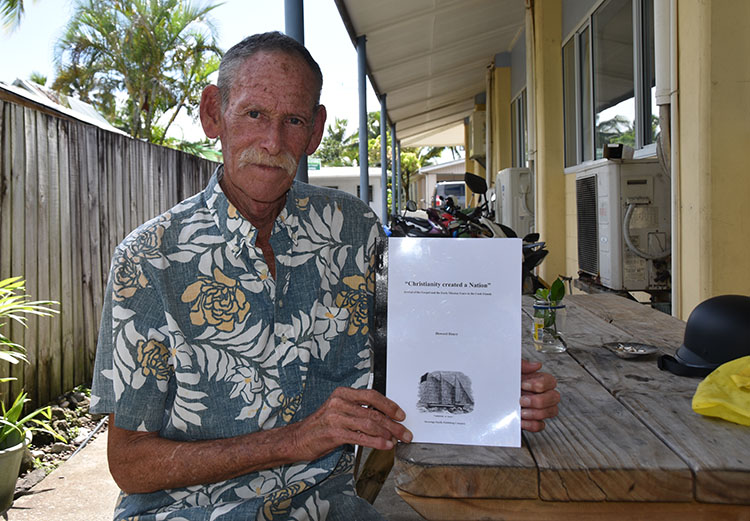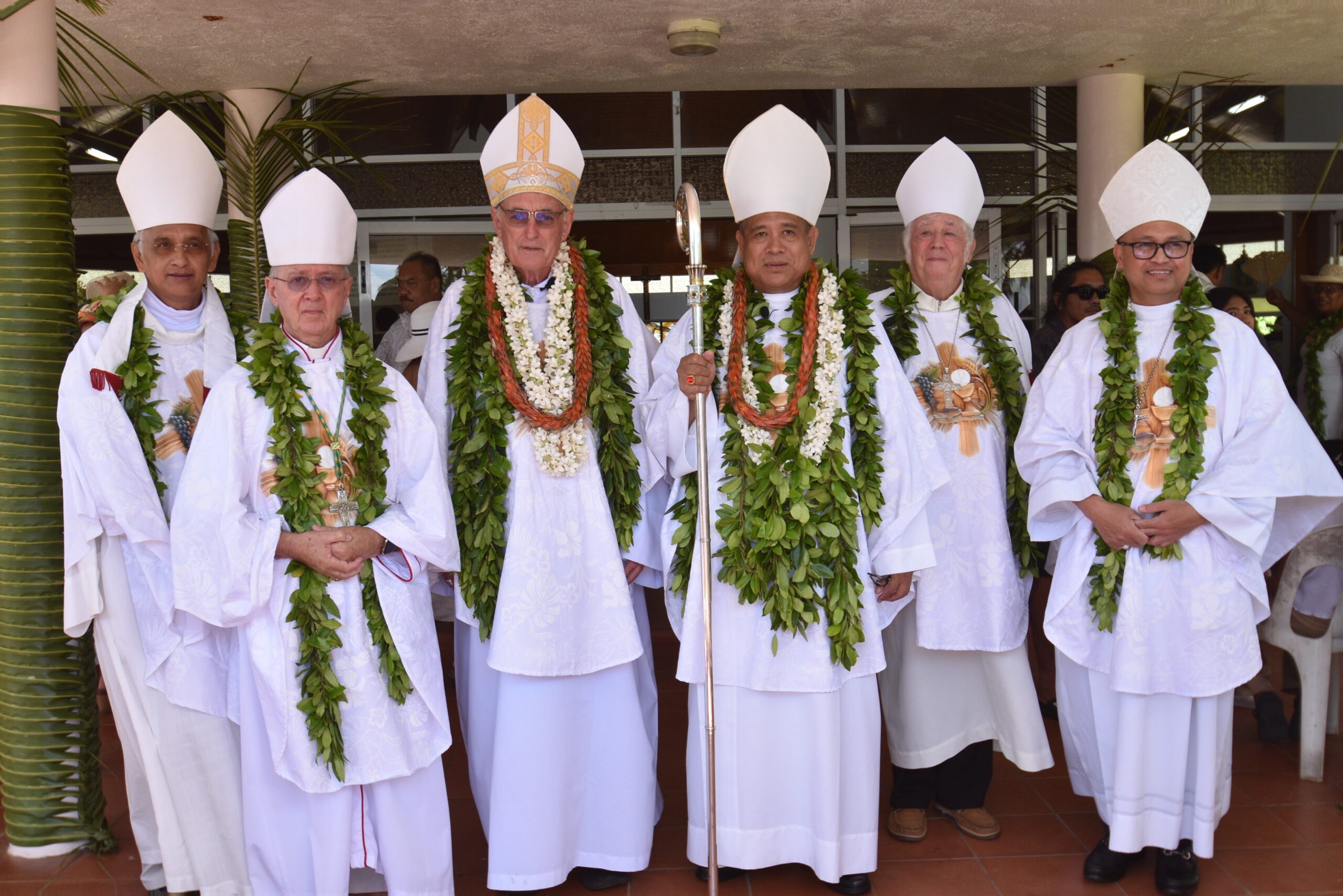Seeds of Christianity: The establishment of three “Mission Stations” on Rarotonga
Saturday 15 July 2023 | Written by Supplied | Published in Church Talk, Features

Author Howard Henry with a copy of his book ‘Christianity created a Nation’. 21082021
Historian and author Howard Henry has been fascinated by the birth of Christianity in the Cook Islands for many years. In a weekly series, Henry chronicles the arrival of Christianity to the Cook Islands and its role in building the nation
Reverend John Williams returned to Rarotonga on Sunday 6 May 1827.
Not only did the missionary bring his wife and family with him, but he also brought Reverend Charles Pitman, and his wife Elizabeth, to be the first European missionary resident on Rarotonga.
The day Rev John Williams and his entourage arrived off Avarua Harbour, Papehia and Tiberio were nowhere to be seen.
It was not until later that day, after Papehia, Tiberio and a number of Christians had arrived from Ngatangiia, that the new arrivals were then able to step ashore.
Rev Williams and those who had arrived with him, were then taken to Ngatangiia.
According to Rev John Williams:
“…heavy rain had rendered the ordinary road unfit for travelling; but as the kind people conveyed goods, wives and children upon their herculean shoulders, all delighted with their occupation, the journey was no means unpleasant.”
SOURCE : “A Narrative of Missionary Enterprises in the South Sea Islands”, by John Williams.
John Snow and Co., London, England, 1837.
Rev Williams landed on Rarotonga with every intention to remain for several months. The purpose of this visit was to ensure that Rev Charles Pitman was settled into his position as the Resident European Missionary at what Rev John Williams thought, would be on the northern side of the island.
The fact that the Christian Village had relocated to Ngatangiia, on the eastern side of Rarotonga, took Rev John Williams by surprise. However, he accepted that situation for the time being.
It did not take the missionary long to realise that Papehia was looked upon by the Christian community as a person of extremely high standing. His social status was even higher to that of the various Ariki.
But in the years that followed, successive European missionaries generated even greater social status by way of dominating “everything” that happened in their Mission District of responsibility. In reality, the European Missionary became the “Governor” of the Mission District designated to be under his control.
Soon after Rev John Williams arrived at Ngatangiia, he was approached by Makea Pori Ariki who told him that the Christian Village should be taken back to Avarua. He also stated that Rev Charles Pitman, should also be living there as well.
A short time after that, Tinomana Enua-ruru-tini Ariki told Rev John Williams that he and his people wanted to return to their “Home Land” of Puaikura on the western side of Rarotonga. This Ariki went on to say that they wanted to have their own Missionary or a “Native Teacher” based in Puaikura as well.
Rev John Williams now had a number of decisions to make. It was obvious to him that the centralisation of the London Missionary Society activities into one single Christian Village on Rarotonga was not going to be accepted by the people living on this island.
Based on what several Ariki had told him, Rev John Williams then concluded that sooner or later Rarotonga would eventually be split into three separate Mission Districts. But not right at this particular time.
But the first decision Rev Williams made was to announce that Rev Charles Pitman was going to remain at Ngatangiia as the Resident Missionary of Takitumu. As a result of that, Rev John Williams said it was time for the Christian community to start building a proper Chapel at this location.
The Missionary also announced, that once the Chapel had been completed, then the tribes of Tinomana, Makea Pori and Karika Ariki would then move back to Avarua on the northern side of the island. Rev John Williams further stated that he would go back to Avarua with them as well.
These announcements were major incentives for the tribes of Te-au-o-Tonga and Puaikura to stop most of their rumblings and lend a “constructive hand” to build the Chapel in Ngatangiia. This building, made out of local timber materials, was formally opened by Rev John Williams on 5 July 1827.
Once the Missionary was satisfied that Rev Charles Pitman was adequately established with the support from both Pa and Kainuku Ariki and their respective tribes, Rev John Williams then left and went to Avarua. He took with him the people from Puaikura and Te-au-o-Tonga as well.
Rev John Williams was fully aware that another European Missionary for Rarotonga was on the way. He was not sure when he would arrive, but he intended to remain on Rarotonga until the Second European Missionary arrived sometime in late 1827 or early 1828.
With the departure of Rev John Williams, Rev Charles Pitman was now the person in charge of all Christian related activities that happened throughout the District of Takitumu.
Soon after he arrived at Rarotonga, Rev John Williams realised that religious instruction in the language of Tahiti was not working out the way he thought it would. In fact, the language factor had proved to be a major stumbling block. As a result of this, Rev Williams gave instructions that from that time forth, the language of Rarotonga had to be used in all Church related activities as much as possible.
Rev John Williams and Rev Charles Pitman then brought together a number of local men who were not only supporters of the Christian faith, but were also dedicated to having their own version of the Bible. The two Missionaries then begin to work with this group, and so put the language of Rarotonga into written form.
Once a basic alphabet had been formulated, it was time to start translating various parts of the New Testament. Both Rev John Williams and Rev Charles Pitman worked at their own pace on different parts of the Bible.
At the same time, Rev John Williams started writing hymns in the language of Rarotonga and several of those hymns are still in the Hymn Book of the Cook Islands Christian Church today including :
1 “Mei te Ua No Runga Mai” and
2 “Na te Metua i Unga Mai”.
In the years that followed, other Missionaries including Reverends Charles Pitman, Aaron Buzacott, William Wyatt Gill, William Gill, Ernest Rudolph Krause, James Chalmers and Bond James also wrote hymns. Their contributions can still be found in the Hymn Book of the Cook Islands Christian Church today.
While Rev John Williams had requested the Mission Ship return to uplift he and his family, he was not sure as to when this would actually happen. So the Missionary then concluded that he wanted to build a small vessel for his own missionary use.
Rev John Williams then told Makea Pori Ariki, and other tribal leaders of the Avarua District, of his intentions. Upon hearing this news, everyone became all excited and so encouraged Rev Williams to start work immediately on this construction project right away.
Reverend Aaron Buzacott and his family arrived at Rarotonga on 16 February 1828.
The vessel Rev John Williams was supervising the construction of, on the shores of Avarua Harbour, was now almost complete at the time the second European Missionary landed on the island.
So when Rev Aaron Buzacott stepped ashore at Rarotonga, the two men met for the very first time. While both men had come out of Protestant lower-middle class families in England with very strong ties to the Church, their paths had never crossed until they greeted each other on the shores of Avarua Harbour.
The two men instantly took a liking to each other. In the time that followed, they formed a very strong bond of friendship and holy brotherhood.
In the years that followed, Rev Buzacott went on to play a major role in transforming the social landscape of not only Rarotonga, but also every other island in the Cook Islands to one degree or another.
It was during the tenure of Rev Aaron Buzacott, from 1828 to 1857, that Christianity was consolidated on almost every island in the group thereby putting in place not only a new religion, but also a whole new civilisation and way of life as well.
The day after he landed at Rarotonga, Rev Aaron Buzacott rolled up his sleeves and reported to Rev John Williams on the shores of Avarua Harbour ready to work on the new vessel.
It did not take long for the Missionary to realise that Rev Buzacott was a very knowledgeable man when it came to building and construction methods. He knew how to handle various tools and Rev Buzacott certainly knew what he was doing in this regard.
After witnessing some of Rev Buzacott’s craftsmanship and in the company of Makea Pori Ariki, Rev John Williams placed his hand on Rev Buzacott’s shoulder and said to Makea : “Now this is the man ‘we’ want here on Rarotonga.” To which Makea Pori Ariki smiled a rather “quiet” smile in agreement.
When construction of the vessel was completed, Rev Williams called her the “Messenger of Peace”.
This vessel then left Rarotonga for Aitutaki on a “shake-down” voyage. Travelling with Rev Williams were a number of local men from Rarotonga who acted as crew for the vessel. Also on board was Makea Pori Ariki.
The “Messenger of Peace” reached Aitutaki on a Sunday. So those on board were just in time to attend the morning service at the local Church at Arutanga. For his part, Rev John Williams gave the sermon and so was the main speaker on this occasion.
While on Aitutaki, Rev John Williams found that Vahapata and Vaineino had not made the progress he thought they should have made. He was troubled about this. So the Missionary then came to the conclusion that sooner or later, Aitutaki would need to have its own European Missionary in residence.
While on Aitutaki, Makea Pori Ariki found two things that caught his eye. The first was the various pigs that were descendants of those brought by Faaori several years previous. The second thing that caught the eye of Makea Pori Ariki was the “cat”. The Ariki had never seen a creature like this before.
After ten days at Aitutaki, Rev John Williams and Makea Pori Ariki left on the “Messenger of Peace” and returned to Rarotonga. On board were 70 pigs and several dozen cats which constituted a prized cargo. Back on Rarotonga, the rat infestation was now a major problem and people had no way of eliminating this pest.
Soon after Rev John Williams landed on Aitutaki, and saw how the cat population had multiplied itself many times over, he had no hesitation in telling Makea Pori Ariki that this animal was badly needed on Rarotonga to combat the rat infestation.
When the “Messenger of Peace” reached Rarotonga, Makea Pori Ariki shared out the pigs he had brought back. But when it came to the cats, he simply turned them all loose and these animals then found their own homes throughout the various communities.
In the time that followed, these cats prospered, multiplied and succeeded in dealing a major blow to the rat infestation problem that had been plaguing Rarotonga for so long.
It was at this time that Tinomana Enua-ruru-tini Ariki reaffirmed to Rev John Williams the desire for he and his tribe to return to Puaikura. The Ariki clearly stated that he wanted to take Papehia to be their “Native Teacher”. And especially so, because Papehia was married to Te Vaerua-o-te-Rangi who was the eldest daughter of Tinomana Ariki.
Rev John Williams agreed to this. So Tinomana Ariki and his tribe packed up their belongings and returned home to Puaikura along with Papehia who was designated to be the first “Native Teacher” of that District.
But instead of going back to live in the hills at Maungaroa, Tinomana Ariki and his tribe went to live on the flat coastal plain. Papehia and the Ariki then designed a basic roading system throughout the district. The Ariki then designated a large portion of land to be divided up as house sites so people could then build their own homes.
Tinomana Ariki also directed that a portion of land in the centre of this new sub-division be designated as the place upon which to build a Church. On the southern side of the Church Tinomana Ariki gave land to be a house site for Papehia. On the northern side of the Chapel, the Ariki took a portion of land for himself, upon which he then had a house built so as he could live right next door.
. . . and so the village of Arorangi came into existence.
That same set-up is still basically in place today.
With Rarotonga now divided with three separate Mission Stations, with their own Resident Missionary or “Native Teacher”, Rev John Williams left Rarotonga with his family on the “Messenger of Peace” in April 1828, after a stay of almost eleven months, and went back to Raiatea.
Even though the Christian population on Rarotonga was still in the minority, Rev Williams was satisfied that significant progress had been made so far.
But with Rev Aaron Buzacott, Rev Charles Pitman and Papehia now in place at their respective Mission Stations, Rev John Williams was confident that the entire population of Rarotonga would soon embrace the Gospel and the Christian faith in the way he thought they originally would.
However … this was not to be the case.
References : “Maretu’s Narrative of Cook Islands History”. Translated by Marjorie Crocombe,
University of Papua New Guinea, December 1974.
: John Williams : “A Narrative of Missionary Enterprises in the South Sea Islands”.
Published by John Snow and Co., London, England, 1837.
: Howard Henry : “Christianity created a Nation”.
Sovereign Pacific Publishing Company, Rarotonga, Cook Islands, 2021.









































